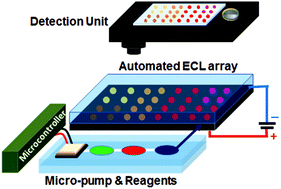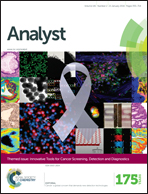Electrochemistry-based approaches to low cost, high sensitivity, automated, multiplexed protein immunoassays for cancer diagnostics†
Abstract
Early detection and reliable diagnostics are keys to effectively design cancer therapies with better prognoses. The simultaneous detection of panels of biomarker proteins holds great promise as a general tool for reliable cancer diagnostics. A major challenge in designing such a panel is to decide upon a coherent group of biomarkers which have higher specificity for a given type of cancer. The second big challenge is to develop test devices to measure these biomarkers quantitatively with high sensitivity and specificity, such that there are no interferences from the complex serum or tissue matrices. Lastly, integrating all these tests into a technology that does not require exclusive training to operate, and can be used at point-of-care (POC) is another potential bottleneck in futuristic cancer diagnostics. In this article, we review electrochemistry-based tools and technologies developed and/or used in our laboratories to construct low-cost microfluidic protein arrays for the highly sensitive detection of a panel of cancer-specific biomarkers with high specificity which at the same time has the potential to be translated into POC applications.

- This article is part of the themed collection: Innovative Tools for Cancer Screening, Detection and Diagnostics

 Please wait while we load your content...
Please wait while we load your content...